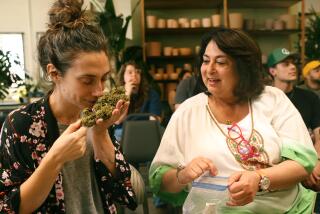Homegrown tea: How to raise your own brewable plants
- Share via
Somewhere around the world, it has long been tea time. Few garden plants come with as long a history as tea (Camelia sinensis). For thousands of years, the caffeinated perennial was harvested for its medicinal uses, mixed with food and steeped as a drink.
Tea originated in the hills of East Asia where southern China borders Laos, Myanmar, Thailand and Vietnam. Nearly 300 varieties have spread globally: to Charleston, S.C. (home of what’s billed as the only tea farm in the U.S.), to Brazil, to the foothills of the Himalayas. The plant is drought-tolerant, easily propagated, grows in sun or shade, and can be harvested dozens of times a year.
Growing your daily cuppa sounds appealing, but it’s not that easy.
At Wattles Farm, the community garden in Hollywood, Gina Thomas planted five varieties -- two Chinese, two Japanese and one Indian -- a few years ago. Now one Chinese variety is the only survivor, but she’s going to try again this spring, this time with varieties specifically for green tea processing.
According to nurseryman Inez Cardenas at Nuccio’s Nurseries, the camellia and azalea specialists in Altadena, the secret is careful monitoring of moisture.
“They like to dry out between waterings,” he said. “Put your finger down in the dirt and if it’s wet, leave it alone.”
Currently Nuccio’s only has seedlings in 4-inch containers. Anything bigger gets sold quickly. The seedlings should go into a 1-gallon pot for at least a year before moving into a 5-gallon pot and ultimately into the ground.
“Go step by step,” Cardenas said. The soil should be more than 50% peat moss and commercial camellia mix on top of a drainage layer of gravel or wire mesh. Even though tea thrives in some of the rainiest places on Earth, it can’t tolerate wet feet. And don’t let the glossy leaves fool you. Tea can be plagued by the same pests that go after the rest of the garden: aphids, caterpillars, mites.
Although some leaves could be plucked as soon as this summer, harvesting can’t truly begin until the bush is a few years old. You remove the newest two or three leaves and the unopened leaf bud at the tip. These leaves are the softest, and the pruning leads to a fuller bush. One plant can produce both green or black tea, although some varieties are better for one or the other. The leaf-drying process takes a few days but is not difficult.
Tea produces wonderfully scented white flowers. If not pruned, the plant can get quite tall, morphing from a shrub into a real tree. The Indian cultivar Camellia sinensis var. assamica can get more than 50 feet tall.
Seeds, harvest tips and an extensive variety of tea sub-species are also available from Camellia Forest Nursery in Chapel Hill, N.C.
The Global Garden, our look at multicultural L.A. through the lens of its landscapes, appears here on Tuesdays. Story suggestions: home@latimes.com.
Bookmark L.A. at Home and join us on Facebook, Twitter and Pinterest.


